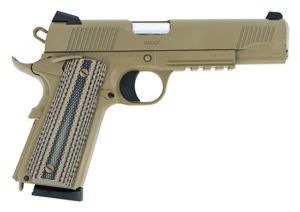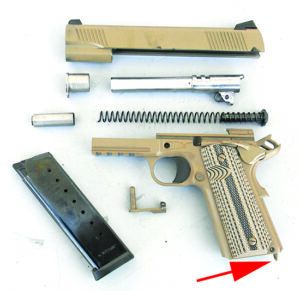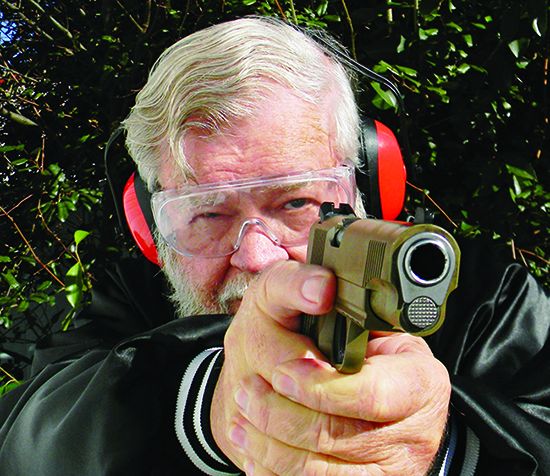A wide selection of 1911 handguns with a rail for mounting combat lights are considered thoroughly modern and useful by many shooters. Those who would like to own a gun with a rail often find a mix of rail types and very expensive handguns. In this test we shoot two affordable handguns with rails and find things we like about both. In common with many other inexpensive 1911 handguns, each could benefit from judicious upgrading, but whether that’s worth it is up to you. Here’s what we found when we fired a Global Defense Thunderbolt, $740, side by side with a Tisas Raider, $630.
Prior to the test firing, we lubricated both pistols along the frame rails and frame ways, barrel hood, cocking block, and barrel bushing. The Thunderbolt is supplied with a single Mec-Gar magazine, with the Tisas arriving with two unmarked magazines. We added a half dozen Mec-Gar seven- and eight-round magazines to the test. The primary test ammunitions were Fiocchi 230- and Winchester 230-grain ball. We usually test pistols with full-metal-jacketed ammunition first to confirm reliability. If a pistol doesn’t function with typical FMJ loads, something is very wrong. We used a Galco TAC slide for most of the range work. The large light rail doesn’t fit most rail-gun holsters.
In accuracy testing, we used three loads. These included the Black Hills Ammunition 185-gain JHP, Federal 230-grain Punch, and Hornady 200-grain XTP. This is a good mix of bullet weights and velocity. We settled on the MTM Caseguard K-Zone shooting rest and fired five-shot groups for accuracy.
Tisas 1911 Raider B45RDG 45 ACP,
$630
Gun Tests grade: B
The Tisas Raider is meant to mimic the legendary Colt MK45, which it does superficially. The pistol is well finished for a gun in the price range, and it performed reliably. We did not like its sight regulation, but this could be addressed by the owner. For most, it’s worth the money, but it could stand improvement.

| Action Type | Short recoil-operated locked breech, single action |
| Overall Length | 8.6 in. |
| Overall Height | 5.5 in. |
| Maximum Width | 1.25 in. |
| Weight Unloaded | 41.5 oz. |
| Weight Loaded | 46.5 oz. |
| Slide Material | Forged Steel |
| Slide Retraction Effort | 18.0 lbs. |
| Receiver Material | Steel |
| Finish | Stainless |
| Front Strap Height | 2.6 in. |
| Back Strap Height | 3.2 in. |
| Barrel Length | 5.0 in. |
| Grip Thickness Max. | 1.25 in. |
| Grip Circumference | 5.2 in. |
| Magazines | (2) 8 round |
| Rear Sight | Fixed drift adjustable |
| Front Sight | Dovetailed steel post |
| Sight Radius | 6.4 in. |
| Trigger Pull Weight | 6.0 lbs. |
| Trigger Span | 2.8 in. |
| Safeties | Slide lock, grip |
| Warranty | 1 year |
| Telephone | (865) 604-6894 |
| Website | TisasUSA.com |
| Made in | U.S. |
Tisas manufactures handguns in Turkey. The company offers entry-level 1911 G.I. types, slightly elevated types with improved sights, compact pistols, several service and military models, and the Raider. The Raider is a close copy of the former Marine Corps issue Colt Rail Gun or MK45. The light rail differs from the MK45 and the finish isn’t quite the same color. Otherwise, the Raider is similar to the now-out-of-production Colt.
In the here and now, the Raider is a half ounce lighter than the Thunderbolt at 41.5 ounces. The Tisas 1911 features a forged frame and slide. Fit and finish seem good without excess lateral play in the slide-to-frame interface. The barrel bushing, locking lugs, and link are well fitted, and the slide runs smoothly on the frame. The action is Series 70. The barrel is stainless steel, while the rest of the pistol is Cerakote. The finish is a flat dark earth or desert camouflage finish. The pistol features well-turned-out G10 grips, a nicely upswept beavertail grip safety, solid trigger, light rail, and a nicely checkered mainspring housing. We were impressed by the nicely made stocks with well-defined bevels. There is no magazine guide or front-strap checkering. The lack of front-strap checkering may be a demerit, but the Raider costs less than the Thunderbolt. It would cost a lot more than $150 to have the front strap checkered, however. We rated the pistol’s G10 stocks superior to the Thunderbolt’s. These checkered grips feature a thumb cut out to make reaching the magazine release easier. The trigger action is crisp and smooth with slightly more take up than the Global Defense pistol. The Raider’s trigger breaks at 6.1 pounds, a good weight, but much more than the Thunderbolt.

An advantage the Tisas has over the Thunderbolt is that the Raider features an ambidextrous safety. It is well fitted with a sharp indent. A Wilson Combat ambidextrous safety cost around $60, and fitting it to the GD would depend on several factors, but would probably run another $50 in gunsmithing charges to make the Thunderbolt left-hand friendly. That makes the Raider the gun for left-handed people. The pistol is supplied in a lock box with a barrel bushing and two magazines, one more mag than the GD.
Firing the pistol was as expected with a modern 1911. Function was good with no failures to feed, chamber, fire, or eject during firing a mix of 230-grain FMJ ammunition. There was no break-in period. It was difficult to gauge any difference in performance between this pistol and the Thunderbolt in rapid fire. We are certain the Thunderbolt’s checkered grip strap provides superior adhesion and abrasion, but it didn’t demonstrate much of a difference in range conditions. The Raider’s G10 grips make up for some of the metalwork’s grippiness. The pistol proved nearly as accurate as the Thunderbolt at 25 yards with most loads. However, the Tisas 1911 fired as much as 4 inches low at 25 yards. We could have filed the front sight down incrementally, painstakingly, and sighted the pistol in. But as issued, it was not properly sighted.
The Thunderbolt failed to function with a magazine of each of the +P loads we had on hand. We thought the Tisas recoil was excessive with +P loads, but the pistol fed, chambered, fired, and ejected with all loads.
Our Team Said: The Tisas has advantages. The pistol is delivered in a locking case with two magazines and a barrel bushing tool. The Global Defense pistol is delivered with one magazine. The sights are similar, but the Thunderbolt gets the nod. Malfunctions with +P loads were not welcome with the Thunderbolt, and that ultimately proved the difference between the two.
As for sight regulation, the original 1911 was designed to fire slightly high at 25 yards, giving troops a good chance to connect at 50 yards. Because the Tisas fired low, we carefully filed the Tisas Raider sight shorter to force the shooter to raise the sight higher and connect more efficiently at 25 yards. We stopped at an inch low and had plenty of sight left. An inexpensive 1911 sometimes requires tuning and upgrades to provide acceptable shooting experiences. Keep than in mind when purchasing an affordable 1911.
| 45 ACP Range Data | ||
| Black Hills 185-grain JHP | Tisas Raider | Global Defense Thunderbolt |
| Average Velocity | 1050 fps | 1069 fps |
| Muzzle Energy | 453 ft.-lbs. | 469 ft.-lbs. |
| Smallest Group | 2.5 in. | 2.4 in. |
| Average Group | 3.2 in. | 2.9 in. |
| Federal Punch 230-grain JHP PD45PD1 | Tisas Raider | Global Defense Thunderbolt |
| Average Velocity | 829 fps | 852 fps |
| Muzzle Energy | 351 ft.-lbs. | 371 ft.-lbs. |
| Smallest Group | 2.2 in. | 1.95 in. |
| Average Group | 2.75 in. | 2.5 in. |
| Hornady Custom 200-grain XTP 9112 | Tisas Raider | Global Defense Thunderbolt |
| Average Velocity | 903 fps | 880 fps |
| Muzzle Energy | 362 ft.-lbs. | 344 ft.-lbs. |
| Smallest Group | 2.4 in. | 2.0 in. |
| Average Group | 2.7 in. | 2.6 in. |
All groups were fired at 25 yards from a benchrest position using a MTM Caseguard K Zone pistol rest. We used a Competition Electronics Pro Chrony to measure velocity. The first screen of the chronograph was 10 feet from the muzzle.
Written and photographed by Robert Campbell, using evaluations from Gun Tests Team members. GT

































